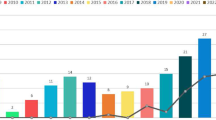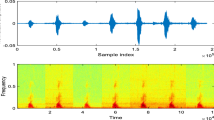Abstract
Imprecise articulation is the major issue reported in various types of dysarthria. Detection of articulation errors can help in diagnosis. The cues derived from both the burst and the formant transitions contribute to the discrimination of place of articulation of stops. It is believed that any acoustic deviations in stops due to articulation error can be analyzed by deriving features around the burst and the voicing onsets. The derived features can be used to discriminate the normal and dysarthric speech. In this work, a method is proposed to differentiate the voiceless stops produced by the normal speakers from the dysarthric by deriving the spectral moments, two-dimensional discrete cosine transform of linear prediction spectrum and Mel frequency cepstral coefficients features. These features and cosine distance based classifier is used for the classification of normal and dysarthic speech.



Similar content being viewed by others
References
ANOVA Test. http://www.statisticshowto.com/probability-and-statistics/hypothesis-testing/anova/. Accessed on 3 Apr 2018.
Antolik, T. K., & Fougeron, C. (2013). Consonant distortion in dysarthria due to Parkinson’s disease, amyotrophic lateral sclerosis and cerebellar ataxia. In INTERSPEECH, pp. 2152–2156.
Chodroff, E., & Wilson, C. (2014). Burst spectrum as a cue for the stop voicing contrast in American English. Journal of Acoustical Society of America, 136(5), 2762–2772.
Fry, D. B. (2009). Acoustic phonetic. Cambridge: Cambridge Universtiy Press.
Jurafsky, D., & Martin, J. H. (2009). Speech and language processing. Upper Saddle River: Prentice Hall.
Karjigi, V., & Rao, P. (2012). Classification of place of articulation in unvoiced stops with spectro-temporal surface modeling. Speech Communication, 54(10), 1104–1120.
Kay, T. S. (2012). Spectral analysis of stop consonants in individual with dysarthria secondary to stroke. Master thesis, Louisiana State University.
Kent, R. D., Weismer, G., Kent, J. F., Vorperian, H. K., & Duffy, J. R. (1999). Acoustic studies of dysarthric speech: Methods, progress and potential. Journal of Communication Disorders, 32, 141–186.
Kim, H., Martin, K., Hasegawa-johnson, M., & Perlman, A. (2015). Frequency of consonant articulation errors in dysarthric speech. Clinical Linguistics and Phonetics, 24, 759–770.
Larcher, A., Lee, K. A., Ma, B., & Li, H. (2014). Imposture classification for text-dependent speaker verification. Journal of Speech Communication, 60, 56–77.
Lin, C., & Wang, H. (2011). Burst onset landmark detection and its application to speech recognition. IEEE Transactions on Audio, Speech, and Language Processing, 19(5), 1253–1264.
Lin, C. Y., & Wang, H. C. (2011). Automatic estimation of voice onset time for word-initial stopsby applying random forest to onset detection. The Journal of the Acoustical Society of America, 130, 514–525.
Linear Prediction Analysis. http://iitg.vlab.co.in/?sub=59&brch=164&sim=616&cnt=1108. Accessed on 3 Apr 2018.
Makhoul, J. (1975). Linear prediction: A tutorial review. Proceedings of the IEEE, 63(4), 561–580.
Mengistu, K., & Rudzicz, F. (2011). Adapting acoustic and lexical models to dysarthric speech. IEEE international conference on acoustics, speech and signal processing, pp. 4924–4927.
Nellore, B. T., Prasad, R. S., Kadiri, S. R., Gangashetty, S., & Yegnanarayana, B. (2017). Locating burst onsets using SFF envelope and phase information. In INTERSPEECH, pp. 3023–3027.
Nirmala, S. R., & Upashana, G. (2017). A review on landmark detection methodologies of stop consonants. Advances in Computational Research, Bioinfo Publication, 8(1), 316–320.
Prathosh, A. P., Ramakrishnan, A. G., & Ananthapadmanabha, T. V. (2015). Classification of place-of-articulation of stop consonants using temporal analysis. In INTERSPEECH, pp. 2655–2658.
Prathosh, A. P. (2015). Temporal processing for event-based speech analysis with focus on stop consonants. Ph.D. Dissertation, Indian Institute of Science, Bangalore.
Rudzicz, F. (2011). Production knowledge in the recognition of dysarthric speech. Ph.D. dissertation, University of Toronto.
Stevens, N., & Blumstein, S. E. (1978). Invariant cues for place of articulation in stop consonants. Journal of Acoustical Society of America, 64(5), 1358–1368.
Author information
Authors and Affiliations
Corresponding author
Additional information
Publisher's Note
Springer Nature remains neutral with regard to jurisdictional claims in published maps and institutional affiliations.
Rights and permissions
About this article
Cite this article
Goswami, U., Nirmala, S.R., Vikram, C.M. et al. Analysis of Articulation Errors in Dysarthric Speech. J Psycholinguist Res 49, 163–174 (2020). https://doi.org/10.1007/s10936-019-09676-5
Published:
Issue Date:
DOI: https://doi.org/10.1007/s10936-019-09676-5




